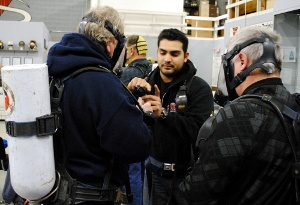STS Safety Training Instructor
Summary
Essential Duties & Responsibilities
Attendance
- Be on time to class, which means 30 minutes before class starts
- Attend and participate in at least one team meeting per month
- Work a minimum of 8 hours per month
Communications
- Be able to use and check a Safety Training Services email address
- Answer ALL calendar invites
- Call-offs; fill your own shift and notify the Training Services Manager two hours in advance
Professionalism
- Dress in proper Safety Training Services approved attire
- Have a well groomed appearance
- Act in a courteous manner to all staff and clients
- Be conscious of your role as a safety instructor, present all materials and demonstrations in a safe and responsible manner
- Be conscious of your audience when using jokes and telling stories
Presentation Knowledge
- Experience, academic credentials, and/or continuing education on subject matter to keep up-to-date on the subject matter you teach
- Assist in designing, planning, or organizing safety training for employees or customers as needed
- Assist in developing, organizing, or obtaining safety training procedure manuals, guides, and course materials such as handouts, workbooks, and visual aids as needed
- Utilize the internet to find recent changes in standards, updated OSHA statistics, and industry specific applications that may be useful in class
Equipment & Housekeeping
- Accountability, maintenance, and safe operation of training props, computers, and projectors.
- Training equipment cleaned and put away in its proper place at the end of class
- Ensure that training equipment is in good, working order at all times & inform Training Services Manager in writing of any equipment that needs to be ordered, replaced, or repaired immediately
- Check-in and check-out all training equipment
- Classroom cleaned, white boards and table wiped, the Training Services Manager notified if sweeping and mopping are needed, props squared away, extra manuals and paperwork turned in, and the garbage taken out
Recordkeeping
- Fill out and turn in ALL required paperwork to Training Coordinator
- Review sign-in sheets for clarity before turning them in
- Monitor, evaluate, and record training activities and program effectiveness
- Effectively evaluate student course critiques for personal and course improvement
Tools & Technology
Tools Used:
- Computers (Desktop, laptop, etc.)
- Printers and Fax Machines
- Digital Cameras
- LCD Projectors
- Pen and Paper
- Telephone and Cell Phone
- Copiers and Scanners
- Simulators and Safety Training Props
Technology Used:
- Computer-based training software (i.e., Microsoft PowerPoint, Adobe Acrobat)
- Document management software (i.e., Microsoft Office Suite)
- Social Networking Programs (i.e., Facebook, YouTube)
- Internet and Email
- Basic PC Troubleshooting
Qualifications & Knowledge
Education and Training - Knowledge of principles and methods for curriculum and training design, teaching and instruction for individuals and groups, and the measurement of training effects.
English Language - Knowledge of principles of the structure and content of the English language including the meaning and spelling of words, rules of composition, and grammar.
Customer and Personal Service - Knowledge of principles and processes for providing customer and personal services. This includes customer needs assessment, meeting standards for services, and evaluation of customer satisfaction.
Communications and Media - Knowledge of media production, communication, and dissemination techniques and methods. This includes alternative ways to inform and entertain via written, oral, and visual media.
Psychology - Knowledge of human behavior and performance, individual differences in ability, personality, and interests; and learning motivation.
Supervisory Responsibilities
Supervises students in the classroom environment.
Physical Demands
Must be able to lift and carry training tools and equipment. Must be able to stand for long periods while presenting material to students.
Skills
Speaking - Talking to others to convey information effectively.
Instructing - Teaching others how to do something.
Learning Strategies - Selecting and using training / instructional methods and procedures appropriate for the situation when learning or teaching new things.
Reading Comprehension - Understanding written sentences and paragraphs in work related documents.
Active Listening - Giving full attention to what other people are saying, taking time to understand the points being made, asking questions when appropriate, and not interrupting at inappropriate times.
Monitoring - Monitoring / Assessing performance of yourself, other individuals, or organizations, to make improvements or take corrective action.
Social Perceptiveness - Being aware of others' reactions and understand why they react the way they do.
Critical Thinking - Using logic and reasoning to identify the strengths and weaknesses of alternative solutions, conclusions or approaches to problems.
Communication
Must be able to communicate to customers, and fellow employees in written, verbal, and via other portals in a clear and concise manner.



